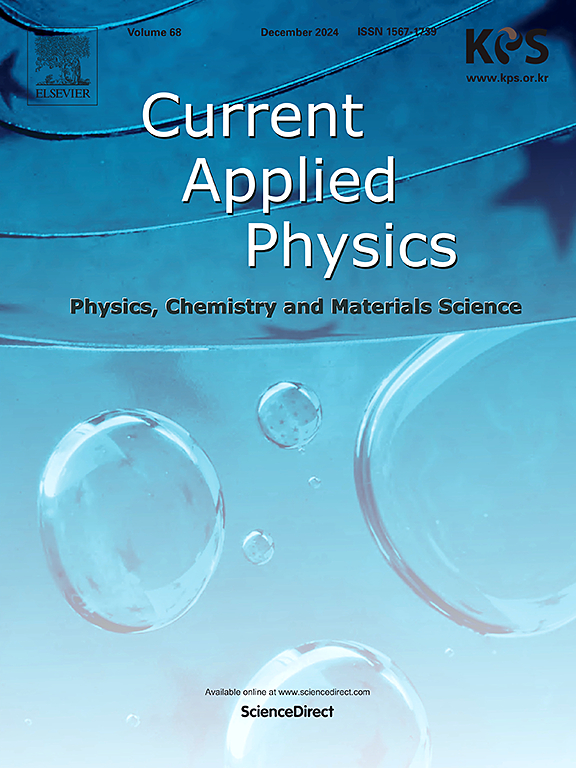Photoluminescence and electrochemical studies of Ce3+-doped Zn2V2O7 nanoparticles synthesized via green route
IF 3.1
4区 物理与天体物理
Q3 MATERIALS SCIENCE, MULTIDISCIPLINARY
引用次数: 0
Abstract
Zn2V2O7:Ce Nanoparticles (NPs) (ZV:Ce), are produced by a solution combustion process mediated by an extract from leaves. The diffraction pattern shows alignment with the ZV host matrix. The crystals grown with monoclinic crystal structure and space group. Furthermore, as the dopant concentration changes, a shift in the diffraction pattern was noticed. Scherrer's approach yielded a crystallite size that nearly matched the results of transmission electron microscopy research. The surface morphology changes from irregularly shaped NPs to hexagonal ones. Furthermore, a modulation of Eg is shown by Tauc's plot analysis of the UV-visible absorption spectra, which shifts from 2.98 to 2.87 eV with increasing dopant quantity. The PL emission spectra at 310 nm consist of peaks located at 417, 457, 482 and 526 nm. The emission peaks at 417, 457 and 482 nm belong to the 5D3/2 → 2F7/2 transition and 526 nm can be attributed to the 5D3/2 → 2F7/2 transition of Ce3+ within the host matrix. The CIE coordinates fall in the light blue emission region. The average CCT of 9078 K shows a cooler appearance. From all these results, the present nano phosphor materials might be a promising candidate in blue LEDs and in display technology. The materials showing a cooler appearance find applications in museums, galleries, offices, outdoor lighting, etc. Electrochemical studies revealed that super capacitance values ranged from 94.67 to 158.12 F/g at a scan rate of 10 mV/s, with increasing Ce3+ quantity in Zn2V2O7 nanoparticles.

绿色路径合成Ce3+掺杂Zn2V2O7纳米粒子的光致发光和电化学研究
Zn2V2O7:Ce纳米粒子(NPs) (ZV:Ce)是由薄荷叶提取物介导的溶液燃烧过程制备的。衍射图显示出与ZV主矩阵的对准。生长的晶体具有单斜晶结构和C2/c(2/m)空间群。此外,随着掺杂剂浓度的变化,衍射图也发生了变化。Scherrer的方法产生的晶体大小几乎与透射电子显微镜研究的结果相匹配。表面形貌由不规则形状的纳米粒子转变为六边形纳米粒子。此外,Tauc的图分析表明,随着掺杂量的增加,Eg在2.98 eV到2.87 eV之间发生了调制。310 nm处的PL发射光谱由位于417、457、482和526 nm处的峰组成。417、457和482 nm处的发射峰属于5D3/2→2F7/2跃迁,526 nm处属于Ce3+在基体内的5D3/2→2F7/2跃迁。CIE坐标落在浅蓝色发射区域。9078 K的平均CCT显示出较冷的外观。从这些结果来看,纳米荧光粉材料可能是蓝色led和显示技术中有前途的候选材料。这种外观凉爽的材料可以应用于博物馆、画廊、办公室、户外照明等场所。电化学研究表明,当扫描速率为10 mV/s时,随着Ce3+含量的增加,Zn2V2O7纳米颗粒的超级电容值在94.67 ~ 158.12 F/g之间。
本文章由计算机程序翻译,如有差异,请以英文原文为准。
求助全文
约1分钟内获得全文
求助全文
来源期刊

Current Applied Physics
物理-材料科学:综合
CiteScore
4.80
自引率
0.00%
发文量
213
审稿时长
33 days
期刊介绍:
Current Applied Physics (Curr. Appl. Phys.) is a monthly published international journal covering all the fields of applied science investigating the physics of the advanced materials for future applications.
Other areas covered: Experimental and theoretical aspects of advanced materials and devices dealing with synthesis or structural chemistry, physical and electronic properties, photonics, engineering applications, and uniquely pertinent measurement or analytical techniques.
Current Applied Physics, published since 2001, covers physics, chemistry and materials science, including bio-materials, with their engineering aspects. It is a truly interdisciplinary journal opening a forum for scientists of all related fields, a unique point of the journal discriminating it from other worldwide and/or Pacific Rim applied physics journals.
Regular research papers, letters and review articles with contents meeting the scope of the journal will be considered for publication after peer review.
The Journal is owned by the Korean Physical Society.
 求助内容:
求助内容: 应助结果提醒方式:
应助结果提醒方式:


